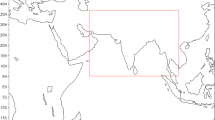Abstract
The Advanced Research Weather Research and Forecasting (AR-WRF) model is used to study the influence of Western Ghats situated along the west cost of peninsular India in the mean characteristics of the Asian summer monsoon (ASM) through numerical simulations. A control simulation (CTRL) is carried out using 11-year (2000–2010) mean initial and lateral boundary conditions from the ERA-Interim reanalysis to simulate the mean atmospheric features of the ASM. The Modern-Era retrospective analysis for research and applications (MERRA) data along with the Tropical Rainfall Measuring Mission (TRMM, 3B42 daily rainfall) data are used to validate the CTRL simulation. The simulated dynamical features and precipitation characteristics during the ASM period agree well with the MERRA reanalysis and TRMM observations. In order to examine the role of Western Ghats on the mean characteristics of the ASM, a sensitivity simulation (NoWG) is carried out with orography reduced to surface over a domain bound between 5°–28°N and 72°–90°E, keeping all other conditions unchanged. This sensitivity analysis showed an enhancement in the low level monsoon flow over the Indian Ocean and peninsular India in the absence of Western Ghats. The prominent up-draft over the west coast of peninsular India observed in the CTRL simulation also decrease in the absence of Western Ghats. The simulated rainfall show a considerable decrease over the west coast and an enhancement over the east coast of peninsular India in the absence of Western Ghats. These simulations clearly depict the importance of Western Ghats in the circulation dynamics and rainfall features during the ASM period.








Similar content being viewed by others
References
Chakraborty A, Nanjundiah RS, Srinivasan J (2002) Role of Asian and African orography in Indian summer monsoon. Geophys Res Lett 29(20). doi:10.1029/2002GL015522
Chakraborty A, Nanjundiah RS, Srinivasan J (2008) Impact of African orography and the Indian summer monsoon on the low-level Somali jet. Int J Climatol. doi:10.1002/joc.1720
Dee DP et al. (2011) The era-interim reanalysis: configuration and performance of the data assimilation system. Q J R Meteorol Soc 137(656):553–597
Findlater J (1969) A major low level air current near the Indian Ocean during the northern summer. Q J R Meteorol Soc 95:362–380
Flohn H (1964) Investigations on the tropical easterly jet. Bonn Meteor Abh 4:1–83
Gadgil S (2003) The Indian monsoon and its variability. Annu Rev Earth Planet Sci 31:429–467
Grossman RL, Durran RD (1984) Interaction of low-level flow with the Western Ghat Mountains and offshore convection in the summer monsoon. Mon Weather Rev 112:652–672
Hahn DG, Manabe S (1975) The role of mountains in the South Asian monsoon circulation. J Atmos Sci 32:1515–1541
Huffman GJ, Adler RF, Bolvin DT, Gu G, Nelkin EJ, Bowman KP, Hong Y, Stocker EF, Wolff DB (2007) The TRMM multisatellite precipitation analysis (TMPA): quasi-global, multiyear, combined-sensor precipitation estimates at fine scales. J Hydrometeorol 8:38–55
Joseph PV, Sijikumar S (2004) Intra seasonal variability of the low-level jet stream of the Asian summer monsoon. J Clim 17:1449–1458
Koteswaram P (1958) The easterly jet stream in the tropics. Tellus Ser A 10:43–57
Lau KH, Kim JH, Sud Y (1996) Intercomparison of hydrologic processes in AMIP GCMs. Bull Am Meteorol Soc 77:2209–2227
Mukhopadhyay P, Taraphdar S, Goswami BN, Kumar KK (2010) Indian summer monsoon precipitation climatology in a high resolution regional climate model: impact of convective parameterization on systematic biases. Weather Forecast 25:369–387
Nair AKM, Rajeev K, Sijikumar S, Meenu S (2011) Characteristics of a persistent pool of inhibited cloudiness and its genesis over the Bay of Bengal associated with the Asian summer monsoon. Ann Geophys 29:1247–1252
NCL-Software (2012) The NCAR Command Language (Version 6.0.0) [Software] Boulder, Colorado, UCAR/NCAR/CISL/VETS, http://dx.doi.org/10.5065/D6WD3XH5
Rienecker MM, Coauthors (2011) MERRA: NASA’s Modern-Era retrospective analysis for research and applications. J Clim 24:3624–3648
Rodwell MJ, Hoskins BJ (1995) A model of the Asian summer monsoon. Part II: cross-equatorial flow and PV behavior. J Atmos Sci 52:1341–1356
Sarkar RP (1966) A dynamical model of orographic rainfall. Mon Weather Rev 94:555–572
Sijikumar S, Rajeev K (2012) Role of the Arabian Sea warm pool on the precipitation characteristics during the monsoon onset period. J Clim 25:1890–1899
Skamarock WC, Klemp JB, Dudhia J, Gill DO, Barker DM, Wang W, Powers JG (2005) A description of the Advanced Research WRF version 2. In: Technical report, National Centre for Atmospheric Research, Boulder, CO
Smith RB (1979) The influence of mountains on the atmosphere. Adv Geophys 21:87–230
Smith RB (1989) Hydrostatic flow over mountains. Adv Geophys 31:1–41
Vigaud N, Roucou P, Fontaine B, Sijikumar S, Tyteca S (2011) WRF/ ARPEGE-CLIMAT simulated climate trends over West Africa. Clim Dyn 36:925–944. doi:10.1007/s00382-009-0707-4
Webster PJ, Magana VO, Palmer TN, Shukla J, Tomas RA, Yania M, Yasunari T (1998) Monsoons: processes, predictability, and the prospects for prediction. J Geophys Res 103 (no C7):14,451–14,510
Wurtele MG, Sharman RD, Datta A (1996) Atmospheric lee waves. Ann Rev Fluid Mech 28:429–476
Xie SP, Xu H, Saji NH, Wang Y, Liu W (2006) Role of narrow mountains in large-scale organization of Asian monsoon convection. J Clim 19:3420–3429
Yanai M, Li CF, Song ZS (1992) Seasonal heating of the Tibetan Plateau and its effects on the evolution of the Asian summer monsoon. J Meteorol Soc Jpn 70:319–351
Acknowledgments
Global Modeling and Assimilation Office (GMAO) and the GES DISC for the dissemination of MERRA data. The ECMWF data portal for obtaining ERA-Interim data. The authors are thankful to the Editor and anonymous reviewers for their constructive comments.
Author information
Authors and Affiliations
Corresponding author
Additional information
Responsible Editor: B. Ahrens.
Rights and permissions
About this article
Cite this article
Sijikumar, S., John, L. & Manjusha, K. Sensitivity study on the role of Western Ghats in simulating the Asian summer monsoon characteristics. Meteorol Atmos Phys 120, 53–60 (2013). https://doi.org/10.1007/s00703-013-0238-8
Received:
Accepted:
Published:
Issue Date:
DOI: https://doi.org/10.1007/s00703-013-0238-8




